You can Download Chapter 13 Amines Questions and Answers, Notes, 2nd PUC Chemistry Question Bank with Answers Karnataka State Board Solutions help you to revise complete Syllabus and score more marks in your examinations.
Karnataka 2nd PUC Chemistry Question Bank Chapter 13 Amines
2nd PUC Chemistry Amines NCERT Textbook Questions
Question 1.
Write IUPAC names of the following compounds and classify them into primary, secondary .and tertiary amines.
(i) (CH3)2CHNH2
(ii) CH3(CH2)2NH
(iii) CH3NHCH(CH3)2
(iv) (CH3)3CNH2
(V) C6H5NHCH3
(vi) (CH3CH2)2NCH3
(vii) m-BrC6H4NH2
Answer:
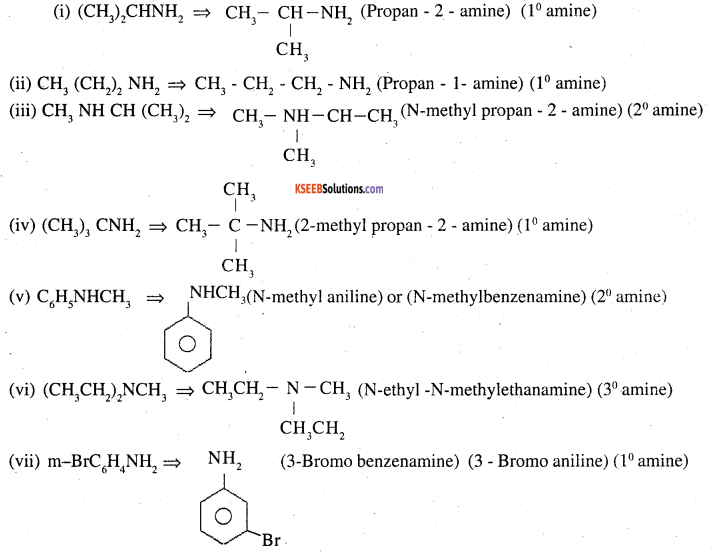
![]()
Question 2.
Give one chemical test to distinguish between the following pairs of compounds,
- Methylamine and dimethylamine
- Secondary and tertiary amines
- Ethylamine and aniline
- Aniline and benzylamine
- Aniline and N-methyl aniline.
Answer:
1. Methylamine and dimethylamine
(1) CH3NH2 (Methyl amine; 1° amine) – Carbyl amine test positive
(2) (CH3)2 NH (Dimethyl amine; 2° amine) – Doesn’t give this test
Carbylamine test:-

2. 2° and 3° amines:-
(1) 2° amine – Libermann Nitrosomine test positive
(2) 3° amine – Libermann Nitrosomine test negative.
Libermann Nitrosomine test :

3. Ethylamine and aniline:
(1) Aromatic amines gives brilliantly coloured orange dye on diazotisation and coupling with phenol.
(2) Ethylamine do not give a dye on diazotisation and coupling with phenol.
Diazotisation:
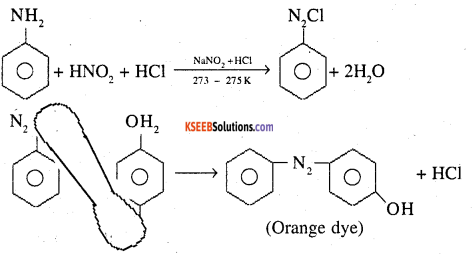
4. Aniline and benzylamine:-
(1) Aromatic (1 °) amine gives coloured dye on diazotisation and coupling with phenol.
(2) Other non aromatic 1° amines and which are not an aromatic 1° amine, will not give a dye.
Diazotisation:-
(a)
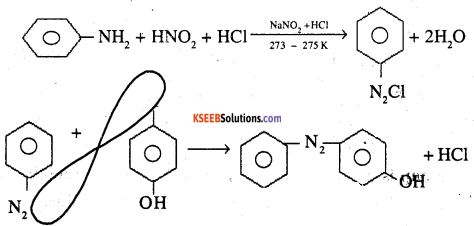
(b)
![]()
5. Aniline and N-methylaniline:-
aniline (1° amine)-Carbylamine test positive
N-methylaniline (2° amine) – Negative
Carbylamine test:-
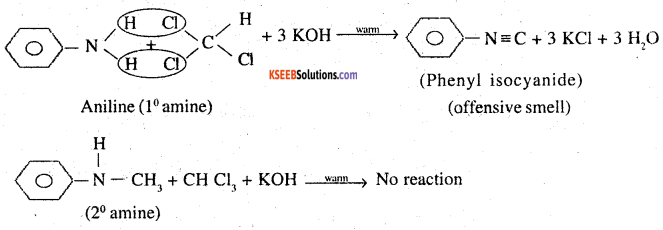
Question 3.
Account for the following:
1. pKb of aniline is more than that of methylamine.
Answer:
(i) Aniline is weaker base than methylamine
Kb of aniline is less than Kb of methylamine.
pKb of aniline is more than pKb of methylamine.
PKb = -logKb
(a) Aniline is weaker base than methylamine because due to resonance, lone pair on N2 gets delocalised over the ring, so electron pair availability is reduced.
(b) In methyl amine due to ‘+I’effect of methyl group, availability of lone pair on N2 atom is increased So is strong base.
2. Ethylamine is soluble in water whereas aniline is not.
Answer:
(i) Lower aliphatic amines are soluble in water because of their ability to form hydrogen bonds with water.
(ii) But in aniline due to larger hydrocarbon part, it hinders hydrogen bond formation with water.
3. Methylamine in water reacts with ferric chloride to precipitate hydrated ferric oxide.
Answer:
Methylamine + H2O ⇌ Methyl ammonium hydroxide

OH- can precipitate out Fe, AI, Cr etc…
3 [CH3NH3]+ OH + FeCl3 → Fe (OH)3↓+ 3CH3NH3Cl
Fe (OH)3 is unstable, so can be hydrated ferric oxide
![]()
![]()
4. Although amino group is o- and p- directing in aromatic electrophilic substitution reactions, aniline on nitration gives a substantial amount of m-nitroaniline.
Answer:
In aniline NH2 increases e density at o- and p- positions due to +R effect. But when it is nitrated by nitrating mixture, substantial amount of m-nitro aniline is formed.
But in acidic medium (Nitrating mixture – HNO3 (c) + H2SO4 (c)).
NH2 + H+ ⇌ NH3+, NH3+ is e– withdrawing group and so is m – directing. So gives larger amount of m- nitroaniline.
5. Aniline does not undergo Friedel-Crafts reaction.
Answer:
Friedel-Craft reaction:-
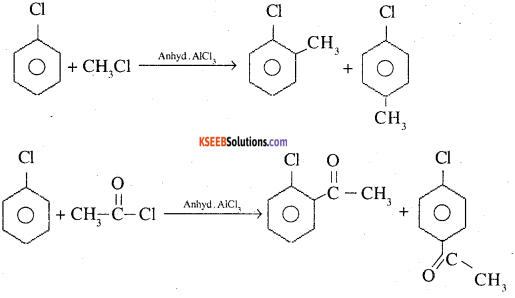
But aniline undergoes salt formation with A1C13 (Lewis acid used as catalyst). So N acquires positive charge and hence acts as strong deactivating group for further reaction.
6. Diazonium salts of aromatic amines are more stable than those of aliphatic amines.
Answer:
In aromatic diazonium salts, due to resonance their is dispersal of positive charge on benzene ring.
But in aliphatic diazonium salts, resonance is not possible, so aliphatic diazonium salts are less stable than aromatic diazonium salts.
7. Gabriel phthalimide synthesis is preferred for synthesising primary amines.
Answer:
Gabriel phthalimide synthesis
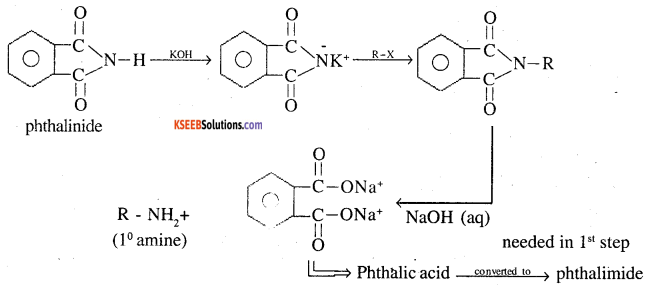
Reaction between alkyl halide (R – X) and ammonia gives mixture, of 1°, 2° and 3° amines with tetraalkyl ammonium halide. Mixture is not separable.
To get pure 1° amine, Gabriel phthalimide synthesis is preferred.
Question 4.
Arrange the following:
1. In decreasing order of the pKb values:
C2H5NH2, C6H5NHCH3, (C2H5)2NH and CH5NH2
Answer:
C6H5NH2 > C6H5NHCH3 > C2H5NH2 > (C2H5)2 NH

2. In increasing order of basic strength:
C6H5NH2, C6H5N(CH3)2, (C2H5)2NH and CH3NH2
Answer:
C6H5NH2 < C6H5N(CH3)2 < CH3NH2 < (C2H5)2 NH
3. In increasing order of basic strength:
(a) Aniline, p-nitroaniline and p-toluidine
Answer:

(b) C6H5NH2, C6H5NHCH3, C6H5CH2NH2.
Answer:
C6H5NH2 < C6H5NHCH3 < C6H5CH2NH2
4. In decreasing order of basic strength in gas phase:
C6H5NH2, (C2H5)2NH, (C2H5)3N and NH3,
Answer:
(C2H5)3N > (C2H5)2NH > C2H5NH2 > NH3
Note: In GAS PHASE, 3° > 2° > 1° Ammonia [No Hydrogen bending and ‘+I’ effect].
5. In increasing order of boiling point:
C2H5OH, (CH3)2NH, C2H5NH2
Answer:
(CH3)2 NH < C2H5NH2 < C2H5OH
Note: Stronger H-bonding, more b.p more solubility
Alcohol > Amine In amines on H attached to N takes part in H-bond.
6. In increasing order of solubility in water:
C6H5NH2, (C2H5)2NH, C2H5NH2.
Answer:
C6H5NH2 < (C2H5)2NH < C2H5NH2
more H-bonding, more solubility
![]()
Question 5.
How will you convert:
1. Ethanoic acid into methanamine
Answer:

2. Hexanenitrile into 1-aminopentane
Answer:

3. Methonal to ethanoic acid
Answer:
![]()
4. Ethanamine into methanamine
Answer:

5. Ethanoic acid into propanoic acid
Answer:

6. Methanamine into ethanamine
Answer:

7. Nitromethane into dimethylamine
Answer:

8. Propanoic acid into ethanoic acid
Answer:

Question 6.
Describe a method for the identification of primary, secondary and tertiary amines. Also write chemical equations of the reactions involved.
Answer:
Hinsberg test:- Benzenesulphonyl chloride (C6H5SO2Cl), which is also known as Hinsberg’s reagent, reacts with primary and secondary amines to form sulphonamides.
(a) The reaction of benzenesulphonyl chloride with primary amine yields N-ethylbenzenesulphonyl amide.

The hydrogen attached to nitrogen in sulphonamide is strongly acidic due to the presence of strong electron withdrawing sulphonyl group. Hence, it is soluble in alkali.
(b) In the reaction with secondary amine, N,N-diethylbenzenesulphonamide is formed.

Since N, N-diethylbenzene sulphonamide does not contain any hydrogen atom attached to nitrogen atom, it is not acidic and hence insoluble in alkali.
(c) Tertiary amines do not react with benzenesulphonyl chloride. This property of amines reacting with benzenesulphonyl chloride, in a different manner is used for the distinction of primary, secondary and tertiary amines and also for the separation of a mixture of amines. However, these days benzenesulphonyl chloride is replaced by p-toluenesulphonyl chloride.
1° amine – clear solution which on acidification gives insoluble product.
2° amine – insoluble product in solution, unaffected by acid
3° amine – No reaction, dissolves an acidification.
![]()
Question 7.
Write short notes on the following:
- Carbylamine reaction
- Diazotisation
- Hofmann’s bromamide reaction
- Coupling reaction
- Ammonolysis
- Acetylation
- Gabriel phthalimide synthesis.
Answer:
1. Carbylamine reaction
1° amines (aromatic/aliphatic) On heating with chloroform and alcoholic solution of KOH gives isocyanides/carbylamines producing unpleasant smell.

2° and 3° (aromatic/aliphatic) do not give this reaction.
2. Diazotisation .
Aromatic 1° amines into diazonium salts by action of HNO2 and dil HCl at ice cold temperature as HNO2 and product are unstable at higher temperature.

3. Hofmann’s bromamide reaction
Involves heating of an amide with bromine and caustic alkali to yield an amine with one carbon less than original amide.

4. Coupling reaction
Diazonium salt acts as electrophile and brings about substitution in electron rich aromatic ring such as phenol and amines. The result is formation of dye.
(i) with phenol – In basic medium (9 – 10 pH) at low temperature (273 – 278 K)

(ii) with amines – In acidic medium (ph = 4 – 5) at low temperature (273 – 278 K)

5. Ammonolysis – Alkyl halide (1°) react with alcoholic ammonia to form 1°, 2°, 3° amines along with 4°ammonium salts. It is carried out by heating alkyl halide with ale solution of NH3 in sealed tube at 370 K.
If ammonia is used in excess, 1° amine is major product

If alkyl halide is excess, it forms all 1°, 2°, 3°, 4° ammonium salts

6. Acetylation
Aliphatic amines:
Introduction of acetyl group (CH3CO-) into any molecule.
1° and 2° amines react with acetyl chloride to form amides
But 3° amines has NO H on N, so do not react.
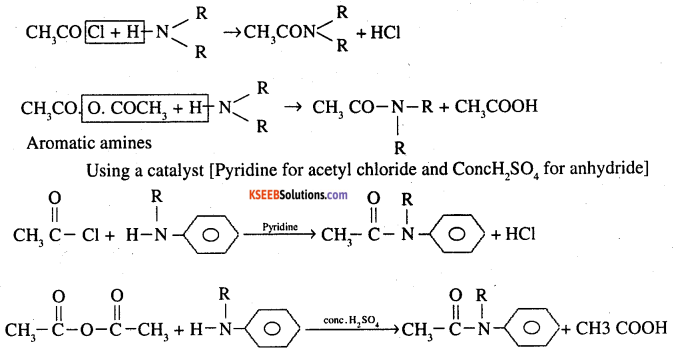
7. Gabriel phthalimide synthesis
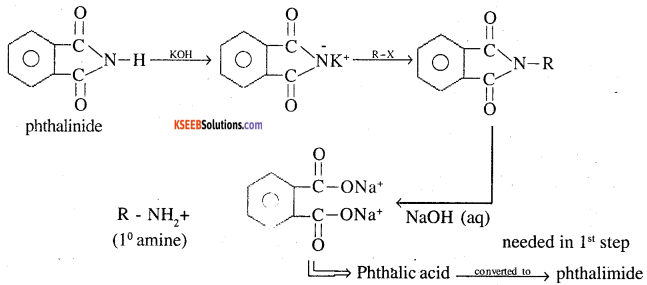
Reaction between alkyl halide (R – X) and ammonia gives mixture, of 1°, 2° and 3° amines with tetraalkyl ammonium halide. Mixture is not separable.
To get pure 1° amine, Gabriel phthalimide synthesis is preferred.
![]()
Question 8.
Accomplish the following conversions:
- Nitrobenzene to benzoic acid
- Benzene to m-bromophenol
- Benzoic acid to aniline
- Aniline to 2,4,6-tribromofluorobenzene
- Benzyl chloride to 2-phenylethanamine
- Chlorobenzene to p-chloroaniline
- Aniline to p-bromoaniline
- Benzamide to toluene
- Aniline to benzyl alcohol
Answer:
1. Nitrobenzene to benzoic acid

2. Benezene to m-bromophenol
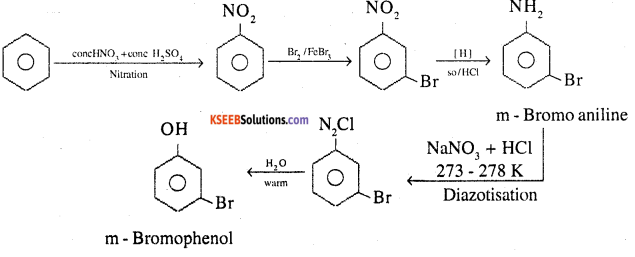
3. Benzoic acid to aniline

4. Aniline to 2,4,6-tribromofluorobenzene

5. Benzyl chloride to 2-phenylethanamine

6. Chlorobenzene to p-choloroaniline
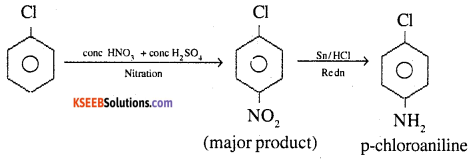
7. Aniline to p-bromoaniline

8. Benzeamide to toluene

9. Aniline to benzeyl alcohal

![]()
Question 9.
Give the structures of A,B and C in the following reactions:
![]()
Answer:

![]()
Answer:

![]()
Answer:
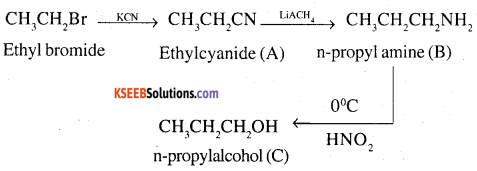
![]()
Answer:

![]()
Answer:

![]()
Answer:
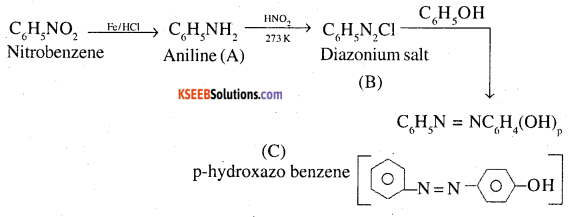
Question 10.
An aromatic compound ‘A’ on treatment with aqueous ammonia and heating forms compound ‘B’ which on heating with Br2 and KOH forms a compound ‘C’ of molecular formula C6H7N. Write the structures and IUPAC names of compounds A, B and C.
Answer:

As ‘C’ is expected as a 1° amine obtained by Hoffmann bromamide degradation of ‘B’ an amide obtained from ‘A’ a carboxylic acid on treatment with NH3 and heat.
So

Question 11.
Complete the following reactions:
1. C6H5NH2 + CHCI3 + alc.KOH →
Answer:
C6H5NH2 + CHCl3 + alc.KOH → C6H5NC + 3 KCl + 3H2O

2. C6H5N2Cl + H3PO2 + H2O →
Answer:

3. C6H5NH2 + H2SO4 (conc.) →
Answer:

4. C6H5N2Cl + C2H5OH →
Answer:

![]()
5. C6H5NH2 + Br2(aq) →
Answer:

6. C6H5N2 + (CH3CO)2 →
Answer:


Question 12.
Why cannot aromatic primary amines be prepared by Gabriel phthalimide synthesis?
Answer:
In this reaction, potassium phthalimide gives phthalimide anion which acts as nucleophile and attacks electrophilic carbon of alkyl halide.
But due to much less reactivity of aryl halide (nucleophilic substitution reaction), 1° aromatic amines can’t be prepared.
Question 13.
Write the reactions of
1. aromatic and
2. aliphatic primary amines with nitrous acid.
Answer:
1. Aromatic amines with nitrous acid
Aromatic 1° amines react with HNO2 at 273 – 278 K to form diazonium compound.

2. Aliphatic amines with HNO2 at 273 – 278 K to give corresponding alcohol, N2, along with other products.

Question 14.
Give plausible explanation for each of the following:
1. Why are amines less acidic than alcohols of comparable molecular masses?
Answer:
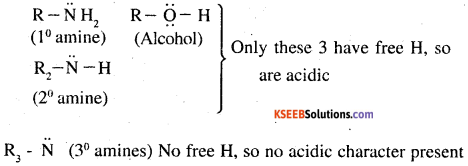
But as ‘O’ is more electronegative than ‘N’. So ‘O’ can accommodate more positive charge and is more stable than ‘N’. So alcohol liberates H+ easily than amines.
So alcohols are more acidic than amines.
2. Why do primary amines have higher boiling point than tertiary amines?
Answer: 1° amines (NH2) has stronger and extensive H – bonding.
3° amines (> N-) has no H, so no H – bonding.
So 1° amines have higher b.p than 3° amines.
3. Why are aliphatic amines stronger bases than aromatic amines?
Answer:

Alkyl amines has positive I effect/electron donating effect, so high electron density on N and stable alkyl ammonium ion formation.
Aromatic amines due to resonance effect and lower stability of aryl ammonium ion than aryl amine, e- density on N is less.
So Alkyl amine is stronger base than aromatic amines.
![]()
2nd PUC Amines Intext Questions
Question 15.
Classify as primary, secondary or tertiary amines.
1.

2.

3. (C2H5)2 CHNH2
4. (C2H5)2 NH
Answer:
1.

→ Primary(As only one of H is replaced by other group, contains – NH2 group)
2.
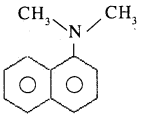
→ No H attached to N, so teritary ( As, > N group is teritary)
3. (C2H5)2 CHNH2 —> Primary (contains – NH2 group)
4. (C2H5)2NH —> Secondary (contains -NH group)
Question 16.
(i) Write a structure of different isomeric amines corresponding to C4H11N
(ii) Write IUPAC names of all isomers
(iii) What type of isomerism is exhibited by different pair of amines
Answer:
C5H11N
Primary amines (-NH2)

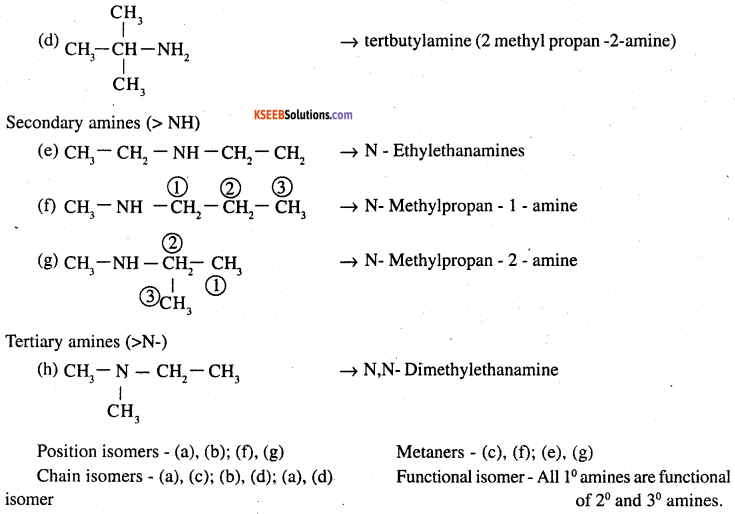
Question 17.
Convert:
(a) Benzene into aniline
Answer:

(b) Benzene into N,N – dimethyl aniline
Answer:

(c) Cl – [CH2]4 – Cl into hexane-1,6 – diamine

![]()
Question 18.
Arrange following in increasing order of their Basic character:
1. C2H5NH2, C6H5NH2, NH3, C6H5CH2NH2
Answer:
C6H5NH2 < NH3 < C6H5CH2NH2 < C2H5NH2 < (C2H5)2NH
2. C2H5NH2, (C2H5)NH, (C2H5)3N, C6H5NH2
Answer:
C6H5NH2 < C2H5NH2 < C2H5)3N < (C2H5)2NH
3. CH3NH2, (CH3)2NH, (CH3)3N, C6H5NH2, C6H5CH2NH2
Answer:
C6H5NH2 < C2H5CH2NH2 < (CH3)3N < CH3NH2 < (CH3)2NH

Question 19.
Compliete following acid-base reaction and name the products:
Answer:

Question 20.
Write reactions of final alkylation product of aniline with excess of methyl iodine is presence of solution
Answer:
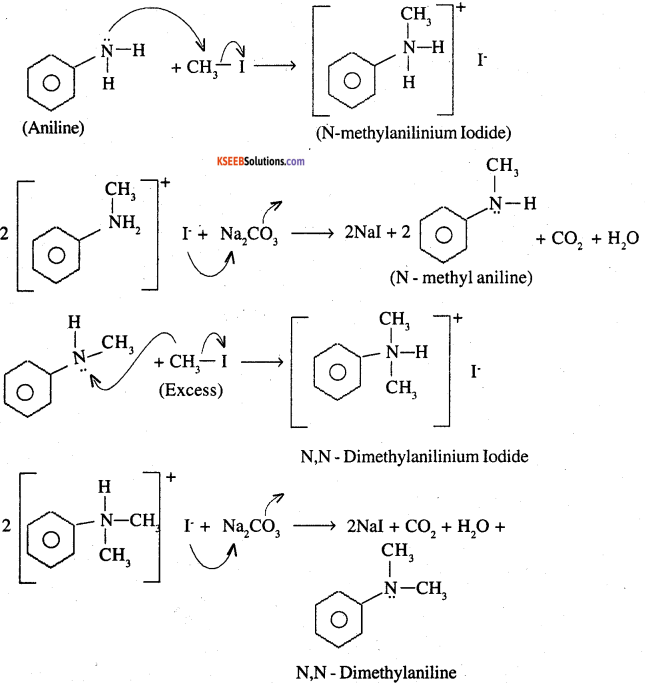
Question 21.
Write chemical reaction of aniline with benzoyl chloride and write product name.
Answer:

Question 22.
Write structure of isomers of C3H9N. Write IUPAC names of isomers which will liberate N2 gas on treatment with nitrous acid. .
Answer:
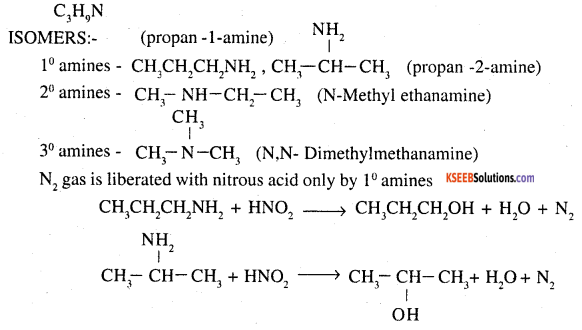
Question 23.
Convert
1. 3-methylaniline into 3-nitrotolune
Answer:

2. Aniline into 1,3,5 – tribromobenzene
Answer:

![]()
2nd PUC Amines Additional Questions
Question 1.
Complete the reaction.
C6H5N2Cl + CH3CH2OH → (Benzene)
Answer:
C6H5N2Cl + CH3CH2OH → C6H6 +CH3CHO + N2 + HCl
Question 2.
Write the IUPAC name of C6H6NHCH3 .
Answer:
N – Methyl aniline.
Question 3.
Which is more soluble in water, NH3 or methylamine ?
Answer:
NH3 is more soluble in water due to more H-bonding.
Question 4.
Which of the following amines has largest value of pKb?
p-Toluidine, Aniline, p- Nitroaniline.
Answer:
Higher the pKb value, weaker is the base
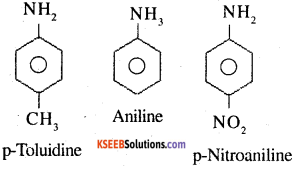
Presence of -CH3 group in the ring will increase the basic character as it is an electron releasing group. Presence of -NO2 group in the ring will decrease the basic character as it an electron withdrawing group. Thus p-nitro aniline will have largest value of pKb.
Question 5.
State two important uses of aniline. (DSB 2000)
Answer:
- In the manufacture of dyes and drugs.
- In the preparation of phenyl isocyanide required for the manufacture of polyurethane plastic.
Question 6.
Why do amines behave as nucleophiles ?
Answer:
Amines behave as nucleophiles. For eg: amines react with alkyl halides, acid chlorides etc.
Question 7.
Why are aqueous solution of amines basic in nature ? (DSB 2006)
Answer:
Aqueous solution of amines which are freely soluble in water (like CH3NH2, C2H5NH2 etc) are basic in nature. It can be explained as follows,
For eg:-

The aqueous solution of methyl amine will be basic in nature, due to the presence of ![]() ions.
ions.
Question 8.
Explain why silver chloride is soluble in aqueous solution of methyl amine. (CBSE 1997, 1998,2002,2004)
Answer:
Due to the formation of water soluble complex
AgCl + 2CH3NH2 → [Ag(CH3NH2)2]+Cl
Question 9.
Write IUPAC name of. (Delhi CBSE 1999)

Answer:
p-nitro-N, N dimethyl aniline.
Question 10.
For an amine RNH2, write the expression for Kb to indicate its base strength. (DBS 2000)
Answer:
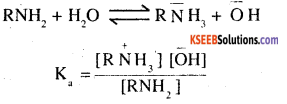
![]()
Question 11.
What does Kb value for an amine stand for? (AISB 2000)
Answer:
Kb value for an amine stands for its basic strength. More the Kb value of an amines more is its basic strength.
Question 12.
Give one example of anbident nucleophile. (CBSE 2001)
Answer:
![]()
acts as ambident nucleophiles.
Question 13.
Why do amines acts as nucleophiles ? (AISB 2007)
Answer:
Aliphatic amines act as nucleophiles. This is due to the availability of lone pair of electrons on nitrogen

Aromatic amines do not behave as nucleophiles. This is because the lone pair of electrons on nitrogen in aromatic amines is involved in resonance with benzene ring, and as such not available for nucleophije attack.
Question 14.
Write IUPAC name of. (AISB 2004)

Answer:
4 – Methoxy benzene amine.
Question 15.
How is phenyl aminomethane obtained from phenyl nitrile. (AISB 2004)
Answer:

Question 16.
Why is an alkyl amine more basic than ammonia ? (CBSE Delhi 2009)
Answer:
This is because of the presence of electron releasing alkyl group (positive I effect) which increases the electron density on nitrogen.
Question 17.
Give the IUPAC name of. H2N — CH3— CH2 — CH = CH2 (CBSE Delhi 2010)
Answer:
But-3-en-l-amine.
2nd PUC Amines Short Answers Questions
Question 1.
How are the following conversions accomplished
(1) Aniline to chlorobenzene
(2) Nitrobenzene to phenol
(3) Aniline to benzoic acid
Answer:
(1)
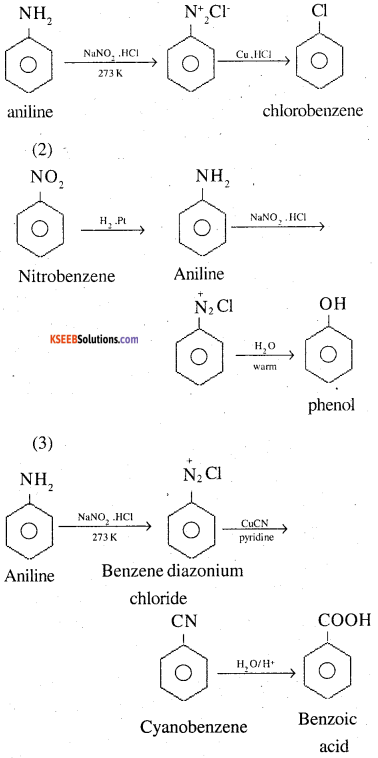
![]()
Question 2.
Account for the following observation:
1. Tertiary amine does not undergo acylation reaction
2. Aniline readily reacts with bromine to give 2,4,6- tribromo aniline (CBSE 2002, 2004)
Answer:
1. Tertiary amine do not undergo acylation reaction because they do not contain a H-atom on the N-atom.
2. This is due to the strong activating effect of the amino group, Halogenation of amines occur very fast and halogens enter at all the three (one P-and two o-positions) positions even in the absence of the catalyst.
Question 3.
Give a chemical test to distinguish between aniline and N-methylaniline. (CBSE 2001, 2006)
Answer:
Aniline being a 1° amine gives carbylamine test i.e. on heating with CHCl3, in presence of alc. KOH, it gives offensive smell of phenyl isocyanide while N-methyl aniline being a 2° amine does not give this test.
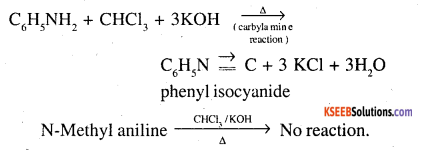
Question 4.
Write one chemical reaction each to illustrate the following
1. Hoffmann’s bromamide reaction
2. Gabriel phthalimide synthesis (CBSE 2008)
Answer:
1. Carbylamine reaction
1° amines (aromatic/aliphatic) On heating with chloroform and alcoholic solution of KOH gives isocyanides/carbylamines producing unpleasant smell.

2° and 3° (aromatic/aliphatic) do not give this reaction.
2. Diazotisation .
Aromatic 1° amines into diazonium salts by action of HNO2 and dil HCl at ice cold temperature as HNO2 and product are unstable at higher temperature.

3. Hofmann’s bromamide reaction
Involves heating of an amide with bromine and caustic alkali to yield an amine with one carbon less than original amide.

4. Coupling reaction
Diazonium salt acts as electrophile and brings about substitution in electron rich aromatic ring such as phenol and amines. The result is formation of dye.
(i) with phenol – In basic medium (9 – 10 pH) at low temperature (273 – 278 K)

(ii) with amines – In acidic medium (ph = 4 – 5) at low temperature (273 – 278 K)

5. Ammonolysis – Alkyl halide (1°) react with alcoholic ammonia to form 1°, 2°, 3° amines along with 4°ammonium salts. It is carried out by heating alkyl halide with ale solution of NH3 in sealed tube at 370 K.
If ammonia is used in excess, 1° amine is major product

If alkyl halide is excess, it forms all 1°, 2°, 3°, 4° ammonium salts

6. Acetylation
Aliphatic amines:
Introduction of acetyl group (CH3CO-) into any molecule.
1° and 2° amines react with acetyl chloride to form amides
But 3° amines has NO H on N, so do not react.
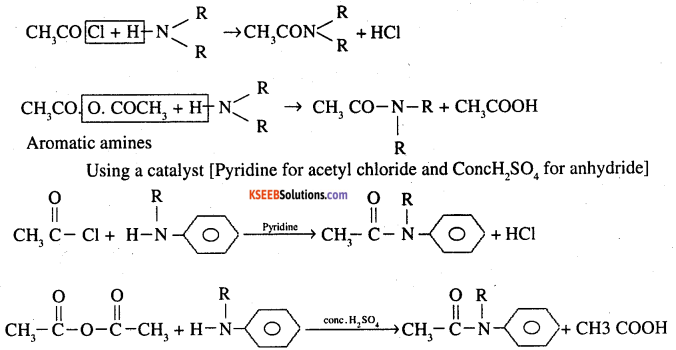
7. Gabriel phthalimide synthesis

Reaction between alkyl halide (R – X) and ammonia gives mixture, of 1°, 2° and 3° amines with tetraalkyl ammonium halide. Mixture is not separable.
To get pure 1° amine, Gabriel phthalimide synthesis is preferred.
![]()
Question 5.
(a) Arrange the following in an increasing order of basic strength in water:
C2H5NH2, (C2H5)2NH, (C2H5)3N and NH3
(b) Arrange the following in increasing order of basic strength in the gas phase
C2H5NH2, (C2H5)2NH, (C2H5)3N and CH3NH2. (CBSE Delhi 2008)
Answer:
(a) In aqueous solution, basic strength decreases in the order. .
(C2H5)NH > (C2H5)3N > C2H5NH2 > NH3
(b) In gaseous phase,(basic strength decreases in the order.
(C2H5)3N > (C2H5)2NH > C2H5NH2 > NH3.
Question 6.
Give an example for each describe the following reactions.
1. Hoffmann’s bromamide reaction
2. Coupling reaction
3. Gattermann reaction (CBSE 2009)
Answer:
1.
1. Carbylamine reaction
1° amines (aromatic/aliphatic) On heating with chloroform and alcoholic solution of KOH gives isocyanides/carbylamines producing unpleasant smell.

2° and 3° (aromatic/aliphatic) do not give this reaction.
2. Diazotisation .
Aromatic 1° amines into diazonium salts by action of HNO2 and dil HCl at ice cold temperature as HNO2 and product are unstable at higher temperature.

3. Hofmann’s bromamide reaction
Involves heating of an amide with bromine and caustic alkali to yield an amine with one carbon less than original amide.

4. Coupling reaction
Diazonium salt acts as electrophile and brings about substitution in electron rich aromatic ring such as phenol and amines. The result is formation of dye.
(i) with phenol – In basic medium (9 – 10 pH) at low temperature (273 – 278 K)

(ii) with amines – In acidic medium (ph = 4 – 5) at low temperature (273 – 278 K)

5. Ammonolysis – Alkyl halide (1°) react with alcoholic ammonia to form 1°, 2°, 3° amines along with 4°ammonium salts. It is carried out by heating alkyl halide with ale solution of NH3 in sealed tube at 370 K.
If ammonia is used in excess, 1° amine is major product

If alkyl halide is excess, it forms all 1°, 2°, 3°, 4° ammonium salts

6. Acetylation
Aliphatic amines:
Introduction of acetyl group (CH3CO-) into any molecule.
1° and 2° amines react with acetyl chloride to form amides
But 3° amines has NO H on N, so do not react.
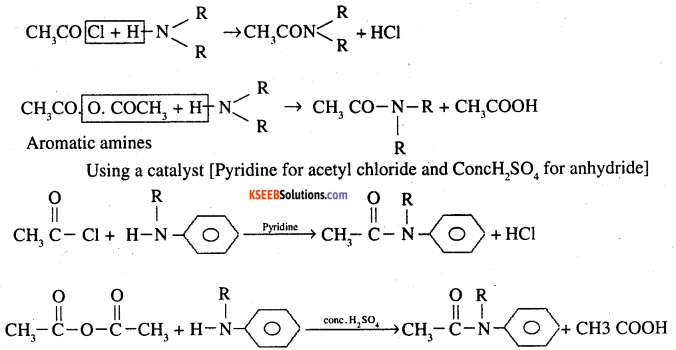
7. Gabriel phthalimide synthesis
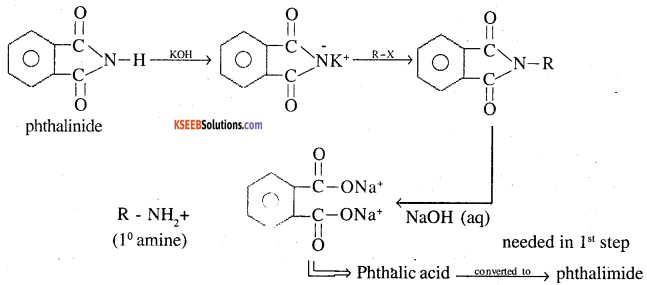
Reaction between alkyl halide (R – X) and ammonia gives mixture, of 1°, 2° and 3° amines with tetraalkyl ammonium halide. Mixture is not separable.
To get pure 1° amine, Gabriel phthalimide synthesis is preferred.
2. The reaction of diazonium salt with phenols and aromatic amines to form azo compounds of the general formula Ar – N = N – Ar is called coupling reaction. The coupling with phenol takes place in mildly alkaline medium while with amines it occurs under faintly acidic condition.

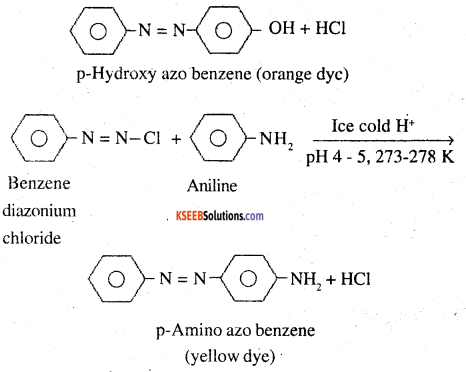
3. Gattermann reaction
When benzene diazonium chloride reacts with Halogen acids in presence of Cu powder, aryl halide is formed as.
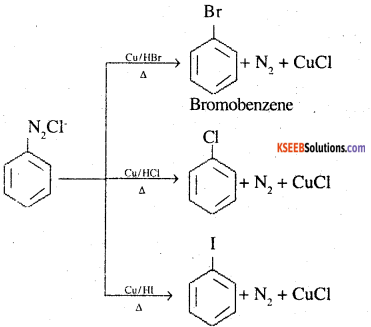
Question 7.
Complete the following reaction equation ?
(1)

(2) C6HSN2CI + H3PO2 + H2O →
(3) C6H5NH2 + Br2 (aq) 4
Answer:
(1)

(2) and (3) Same as NCRT text book Q.No. 11.
![]()